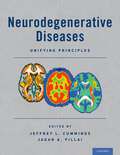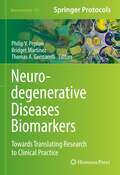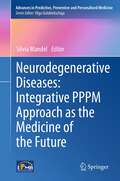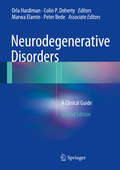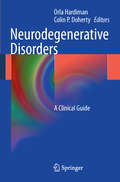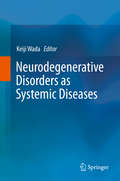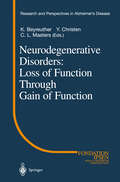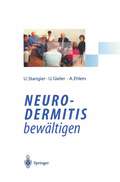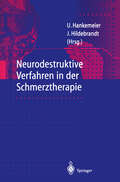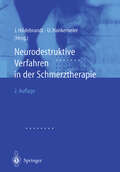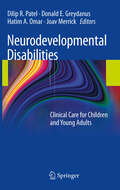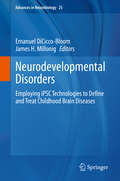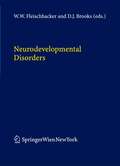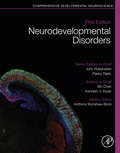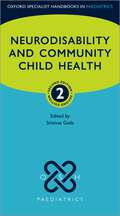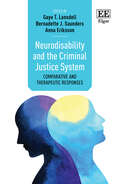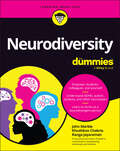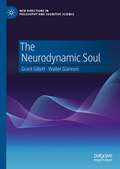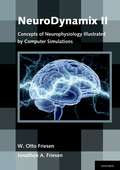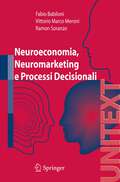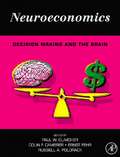- Table View
- List View
Neurodegenerative Diseases: Unifying Principles
by Jagan A PillaiAs the global population ages the impact of neurodegenerative diseases like Alzheimer's disease and Parkinson's disease are significant forces in shaping human health and quality of life in the 21st century. Insights into understanding these diseases, and knowing how to treat them are major frontiers of scientific research. Neurodegenerative Diseases: Unifying Principles is the result of a conceptual revolution over the last decade in our understanding of neurodegenerative diseases as sharing unifying features. There is an increasing appreciation of the common biological and pathological features across seemingly varied neurodegenerative diseases that entail protein misfolding dysfunction and its consequences over time. Providing an overview of this conceptual change is the main theme for the book. Conventional approach emphasize the differences among neurodegenerative disorders, here Drs. Cummings and Pillai compile the increasingly compelling evidence that these disorders share many features and that insights in one may be rapidly translated into advances in another. The goal is to accelerate understanding by showing linkages among biological, pathological, can clinical aspects of this class of diseases. This collection of 19, inter-related chapters, articulates and broadens our view of the unifying features that initiate and drive disease progression across a variety of neurodegenerative diseases over time. This book will serve as an outstanding sourcebook of insights from experts that have played key roles in this story.
Neurodegenerative Diseases Biomarkers: Towards Translating Research to Clinical Practice (Neuromethods #173)
by Philip V. Peplow Bridget Martinez Thomas A. GennarelliThis volume presents recent data on the latest achievements in new and emerging technologies for biomarkers and for innovations in their assessment. The chapters cover topics such as activation of microglia and macrophages in neurodegenerative diseases; oxidative stress and cellular dysfunction in neurodegenerative diseases; TSPO PET imaging as a biomarker of neuroinflammation in neurodegenerative disorders; and imaging biomarkers in Huntington's disease and amyotrophic lateral sclerosis. In the Neuromethods series style, chapters include the kind of detail and key advice from the specialists needed to get successful results in your laboratory. Cutting-edge and comprehensive, Neurodegenerative Diseases Biomarkers: Towards Translating Research to Clinical Practice is a valuable resource for both experimental and clinical experts in the field of neurodegenerative diseases who are looking to expand their knowledge of novel biomarkers in different types of neurodegenerative diseases.
Neurodegenerative Diseases: Integrative PPPM Approach as the Medicine of the Future (Advances in Predictive, Preventive and Personalised Medicine)
by Silvia MandelThis book will compile a collection of chapters dedicated to varied aspects of PPPM in neuropsychiatric and neurodegenerative diseases. Among the topics to be covered are:Recent advances in ALS research News about Clinical aspects and advanced therapy approaches in personalized treatment of ALS Schizophrenia: New treatments and clinical aspects Predictive, Preventive and Personalised Medicine in aging macular degeneration Advances in Multiple Sclerosis Pharmacogenetics, Tailoring Treatment Efficacy, Safety and Regimen Selection Multiple sclerosis related biomarkers: perspectives for clinical application Preventive clinical trials in brain aging: new trends & the need of guidelines MCI_ clinical guidelines in early diagnosis of dementia Alzheimer's disease: diagnostics, prognostics and the road to prevention Biomarkers for early diagnosis of Parkinson's and Alzheimer's diseases Synucleinopathies, tauopathies, TDP-43 proteinopathies and amyloidosis PSP, MSA and other parkinsonisms
Neurodegenerative Disorders: A Clinical Guide
by Orla Hardiman Colin P. Doherty Marwa Elamin Peter BedeThis new edition provides an accessible guide to the commonest neurodegenerative diseases, outlining the main clinical features, treatment options and outcomes of the conditions most frequently encountered in clinical practice.Beginning with an overview of the general principles that underlie degeneration, and the contribution of established and new diagnostics techniques, the book goes on to describe the most common neurodegenerative conditions and, new for the second edition, also HIV dementia and multiple sclerosis. Final chapters cover important management issues including the use of palliative care strategies, biomarkers and neuropsychology. Written by experts in the field internationally Neurodegenerative Disorders, Second Edition is a practical guide for clinicians that will be indispensable for the management of these conditions.
Neurodegenerative Disorders: A Clinical Guide
by Orla Hardiman and Colin P. P. DohertyNeurodegenerative Disorders provides an accessible guide to the commonest neurodegenerative diseases, outlining the main clinical features, treatment options and outcomes of the conditions most frequently encountered in clinical practice. Beginning with an overview of the general principles that underlie degeneration, and the contribution of established and new diagnostics techniques, the book goes on to describe the most common neurodegenerative conditions including Alzheimer Disease; Dementia and Cerebrovascular Disease; Parkinson’s Disease; Fronto-Temporal Dementia; Amyotrophic Lateral Sclerosis; Huntington’s Disease; Parkinsonism Plus syndromes and Prion Diseases. Final chapters cover important management issues including the use of palliative care strategies, advance directives and competence.Written by experts in the field internationally Neurodegenerative Disorders is a practical guide for clinicians that will be indispensable for the management of these conditions.
Neurodegenerative Disorders as Systemic Diseases
by Keiji WadaThis book sheds new light on neurodegenerative disorders as systemic diseases. Classically, neuronal cell death was a hallmark of such disorders. However, it has become evident that neural dysfunction is more important in the pathophysiology of neurodegenerative disorders. More recently, the prionoid-spreading hypothesis of disease-causing molecules has attracted a great deal of attention. Therapeutic strategies thus must be reconsidered in the light that neurodegenerative disorders are indeed systemic diseases. The first part of this book introduces the concept of neurodegeneration in biology and pathophysiology. The second part focuses on clinical evaluation and biomarkers from the perspective of this new concept, while the third summarizes the risk factors of neurodegeneration. The fourth part of this work indicates future directions of treatment, and the final part discusses health promotion for prevention and quality of life. This book will be of interest to both researchers and medical personnel, and provides a fresh approach to neurodegenerative diseases, paving the way to new research and improved quality of health care for patients.
Neurodegenerative Disorders: Loss of Function Through Gain of Function (Research and Perspectives in Alzheimer's Disease)
by Konrad BeyreutherNeurodermitis bewältigen: Verhaltenstherapie Dermatologische Schulung Autogenes Training
by Ulrich Stangier Uwe Gieler Anke EhlersSchritt für Schritt beschreibt dieses Manual ein erprobtes Therapieprogramm zur umfassenden Behandlung von Neurodermitis-Patienten.Die Therapie umfaßt drei Bausteine:- Psychologisch-verhaltenstherapeutisches Programm- Dermatologische Schulung- Autogenes TrainingAufbau und Ablauf der Therapie werden verständlich, praxisnah und klar strukturiert dargestellt. Hinweise zur Bewältigung von Schwierigkeiten erleichtern die Umsetzung.Das Manual bietet fundiertes psychotherapeutisches Fachwissen, berücksichtigt aber gleichzeitig die für eine effiziente Behandlung nötigen dermatologischen Kenntnisse.Für Betroffene enthält das Buch eine Reihe von Patienten-Informationen und hilfreichen Übungen zur Unterstützung der Therapie.
Neurodestruktive Verfahren in der Schmerztherapie
by U. B. Hankemeier J. HildebrandtNeurodestruktive Methoden haben in der Behandlung chronischer Schmerzen einen hohen Stellenwert - insbesondere nach der deutlichen Verbesserung der Durchführungstechnik und der bildgebenden Kontrollverfahren.Jetzt gibt es endlich ein Buch, das Ihnen aktuell und praxisgerecht alle klinisch relevanten Informationen zur Verfügung stellt!- Die wichtigsten Indikationsgebiete, z.B. Wirbelsäulenerkrankungen, Gesichtsschmerz, Tumorschmerz- Zielpunkte, Verfahren und Anatomie schmerzleitender Systeme- Nebenwirkungen und Komplikationen der Methoden- Verständlich und anschaulich durch zahlreiche AbbildungenEin Leitfaden, der Ihnen konkrete Unterstützung bei der praktischen Umsetzung der neurodestruktiven Schmerztherapie bietet.
Neurodestruktive Verfahren in der Schmerztherapie
by J. Hildebrandt U. B. HankemeierEinzigartig im deutschsprachigen Raum!- Die wichtigsten Indikationsgebiete- Anatomie, Physiologie, Pathophysiologie- Verfahren, Nebenwirkungen und Komplikationen- Aktuelle Bildgebung in der perkutanen Schmerztherapie- Gepulste Technik bei der Radiofrequenz- Intradiskale Läsion (IDET)
Neurodevelopmental Disabilities: Clinical Care for Children and Young Adults
by Dilip R. Patel, Donald E. Greydanus, Hatim A. Omar and Joav MerrickIncreasingly more and more children with developmental disabilities survive into adulthood. Pediatricians and other clinicians are called upon to care for an increasing number of children with developmental disabilities in their practice and thus there is a need for a practical guide specifically written for paediatricians and primary care clinicians that addresses major concepts of neurodevelopmental pediatrics. In the United States, the specialty training leading to a conjoint board certification by the American Board of Pediatrics and American Board of Psychiatry and Neurology, requires a total of 6 years of training (2 years of pediatrics, 1 year of neurology, 18 months of child neurology, 18 months of neurodevelopmental disabilities). As of December 2006, in the US, there were 241 pediatricians and 55 child neurologists certified in the subspecialty of Neurodevelopmental Disabilities. Thus most of the children with developmental disabilities are seen by pediatricians and therefore it is important for these pediatricians to be well informed of common issues in the field. The 60,000 or so pediatricians in the United States (and hundreds more in other countries) are the main target audience for a practical book on neurodevelopmental pediatrics.
Neurodevelopmental Disorders: Employing iPSC Technologies to Define and Treat Childhood Brain Diseases (Advances in Neurobiology #25)
by Emanuel DiCicco-Bloom James H. MillonigThis book contains a compendium of induced pluripotent stem cells (iPSCs) articles and reviews concerning state of the art technologies and how they are being applied to human neurodevelopmental disorders. With the establishment of effective technologies to produce iPSCs and their derivatives, like neural precursors, neurons, and glia, researchers have new platforms to study neurodevelopmental disorders. iPSC technology enables researchers to study how human neurons develop in individuals with neurodevelopmental disorders, providing an unparalleled opportunity to investigate their etiology. In turn, researchers have now begun to understand the underlying molecular and cellular pathways that contribute to human diseases. iPSCs technologies also provide an emerging tool for future translational studies and disease classification. The chapters will emphasize how among the diverse idiopathic and genetic disorders, there are common clinical as well as cellular and molecular phenotypes.
Neurodevelopmental Disorders
by W. Wolfgang Fleischhacker David J. BrooksWe have great pleasure to present the latest extension of the European Institute of Health Care book series. This volume is devoted to neurodevelopmental d- orders. Again, we had the privilege to be able to work with reknowned experts who have agreed to contribute to this endeavour. The book comprises a number of topics related to psychosocial and motor development and is exemplary with regard to its comprehensiveness, as reviews of the topics presented are generally not available in a single publication. It starts with a timely and critical discussion of the genetics of attention deficit hyperactivity disorder by Dr. Buitelaar in which prospects and challenges of this approach are outlined. The next chapter by Drs. Nicolson and Fawcett deals with dyslexia and its relationship to cerebellar function providing a framework that can explain motor, speed, and phonological deficits in a unified approach. Diagnostic and treatment aspects of speech development disorders are the focus of Dr. Zorowka’s contribution in which, among other issues, the necessity of mul- professional cooperation is stressed. Dr. Sigmundsson then focuses on disorders of motor development. 6-10 % of children have motor competence well below the norm, which often persist. The clumsy child syndrome must be seen and treated as a neurological dysfunction. The relationship between tic disorders and obsessive compulsive disorder, two disturbances generally treated by different medical specialists, namely neurologists or psychiatrists, is then reviewed by Drs.
Neurodevelopmental Disorders: Comprehensive Developmental Neuroscience
by John Rubenstein Pasko RakicNeurodevelopmental Disorders, the latest release in the Comprehensive Developmental Neuroscience series, presents the most thorough coverage available, addressing all aspects on how the nervous system and its components develop. This book brings together the latest research in this rapidly evolving field, with section editors discussing the technological advances that are enabling the pursuit of new research on brain development. This volume focuses on neurodevelopmental disorders in humans and experimental organisms. Particular attention is paid to the effects of abnormal development and on new psychiatric/neurological treatments being developed based on our increased understanding of developmental mechanisms.Features leading experts in various subfields as section editors and article authorsPresents articles that have been peer reviewed to ensure accuracy, thoroughness and scholarshipCovers disorders of the nervous system that arise through defects in neural development
Neurodisability and Community Child Health (Oxford Specialist Handbooks in Paediatrics)
by Srinivas GadaContaining concise, updated, and easy-to-use summaries on a comprehensive range of clinical scenarios and conditions encountered by paediatricians and multi-disciplinary professionals in their everyday practice, this new edition of Neurodisability and Community Child Health has been substantially revised to be the ideal companion for anyone working with children.
Neurodisability and Community Child Health (Oxford Specialist Handbooks in Paediatrics)
Containing concise, updated, and easy-to-use summaries on a comprehensive range of clinical scenarios and conditions encountered by paediatricians and multi-disciplinary professionals in their everyday practice, this new edition of Neurodisability and Community Child Health has been substantially revised to be the ideal companion for anyone working with children.
Neurodisability and the Criminal Justice System: Comparative and Therapeutic Responses
This thought-provoking book highlights the increasing recognition of the prevalence of neurodisability within criminal justice systems, discussing conditions including intellectual, cognitive and behavioural impairments, fetal alcohol spectrum disorders and traumatic and acquired brain injury. International scholars and practitioners demonstrate the extent and complexity of the neurodisability experience and present practical solutions for criminal justice reform.Examining the growing body of evidence which illustrates the significant over-representation of neurodisability amongst prison and juvenile justice populations, this critical book explores the challenges faced by people with a neurodisability who come into contact with the justice system. These challenges include: difficulty understanding interactions with police, navigating court processes, comprehending sentencing orders, and coping with prison and post-release life, which can lead to repeat victimisation and criminalisation. Overall, this book establishes that justice systems are often unable to meet the specific needs of people with a neurodisability and that there is a significant lack of appropriate support within the community aimed at prevention and diversion.Providing broad interdisciplinary insights, this timely book will prove a vital resource for scholars and students of criminal law, law and society, criminology, neuroscience and social work. It will also be of value to legal practitioners, law enforcement, prison employees and welfare professionals engaged with individuals with a neurodisability.
Neurodiversity For Dummies
by John Marble Khushboo Chabria Ranga JayaramanA quick and easy way to understand neurodiversity as written by neurodivergent people and our families Neurodiversity For Dummies is your essential guide in understanding neurodivergent conditions like autism, ADHD, dyslexia, and more. This quick and easy guide is perfect for anyone needing to know more about neurodiversity. And that’s all of us—because recent estimates say that 15-20% of the world’s population have some form of neurodivergence. Your life is filled with neurodivergent people that you know and love, whether you realize it yet or not. It’s time to learn to support and include the neurodivergent among us, and to understand how neurodiversity impacts society and the workplace. This is for the neurodivergent person wanting to thrive in life, for parents and caregivers seeking success for their child, and for teachers who are working to make a difference in their students’ lives. Filled with practical advice, Neurodiversity for Dummies also provides a helping hand to service providers, assistance for workplace managers and colleagues, and understanding for family members and friends. Imagine a world where we all understood ourselves better and appreciated more deeply the differences in others. No matter how your own brain thinks, Neurodiversity for Dummies is for you. Check out this jargon-free introduction for an essential overview. Explore the Spectrum of Neurodiversity: Understand in plain language the world of autism, ADHD, dyslexia, and other neurodivergent conditions. Unlock Hidden Talents: Move yourself beyond common myths and misconceptions to discover how neurodiversity actually works. Learn how neurodiversity has always been with us, why society needs neurodivergent traits, and how neurodiversity can be a wellspring of innovation, creativity, and out-of-the-box thinking. Discover Yourself: Whether you are a neurodivergent person or not, learn how to understand your own normalcy, advocate for your needs, and build meaningful connections with those who think and experience the world differently than you. Change the World Around You: Be empowered through simple steps you can take to create inclusive environments for neurodivergent individuals in your school or workplace. Uncover proven strategies that cultivate a culture of acceptance and respect, where the unique perspectives of all individuals are valued and celebrated. We believe in providing parents with better supports, empowering individuals with information, and shaping a world where we are all seen and understood. With an author team composed of neurodivergent individuals and parents writing together, Neurodiversity for Dummies is an example of the power of neurodiversity when put into action. It’s why we wrote this for you. Don’t miss your chance to embark on this transformative journey. Order your copy of Neurodiversity for Dummies now to better understand yourself and others, and to join the movement that is revolutionizing how we understand and support the diversity of the human mind.
Neurodiversity For Dummies
by John Marble Khushboo Chabria Ranga JayaramanA quick and easy way to understand neurodiversity as written by neurodivergent people and our families Neurodiversity For Dummies is your essential guide in understanding neurodivergent conditions like autism, ADHD, dyslexia, and more. This quick and easy guide is perfect for anyone needing to know more about neurodiversity. And that’s all of us—because recent estimates say that 15-20% of the world’s population have some form of neurodivergence. Your life is filled with neurodivergent people that you know and love, whether you realize it yet or not. It’s time to learn to support and include the neurodivergent among us, and to understand how neurodiversity impacts society and the workplace. This is for the neurodivergent person wanting to thrive in life, for parents and caregivers seeking success for their child, and for teachers who are working to make a difference in their students’ lives. Filled with practical advice, Neurodiversity for Dummies also provides a helping hand to service providers, assistance for workplace managers and colleagues, and understanding for family members and friends. Imagine a world where we all understood ourselves better and appreciated more deeply the differences in others. No matter how your own brain thinks, Neurodiversity for Dummies is for you. Check out this jargon-free introduction for an essential overview. Explore the Spectrum of Neurodiversity: Understand in plain language the world of autism, ADHD, dyslexia, and other neurodivergent conditions. Unlock Hidden Talents: Move yourself beyond common myths and misconceptions to discover how neurodiversity actually works. Learn how neurodiversity has always been with us, why society needs neurodivergent traits, and how neurodiversity can be a wellspring of innovation, creativity, and out-of-the-box thinking. Discover Yourself: Whether you are a neurodivergent person or not, learn how to understand your own normalcy, advocate for your needs, and build meaningful connections with those who think and experience the world differently than you. Change the World Around You: Be empowered through simple steps you can take to create inclusive environments for neurodivergent individuals in your school or workplace. Uncover proven strategies that cultivate a culture of acceptance and respect, where the unique perspectives of all individuals are valued and celebrated. We believe in providing parents with better supports, empowering individuals with information, and shaping a world where we are all seen and understood. With an author team composed of neurodivergent individuals and parents writing together, Neurodiversity for Dummies is an example of the power of neurodiversity when put into action. It’s why we wrote this for you. Don’t miss your chance to embark on this transformative journey. Order your copy of Neurodiversity for Dummies now to better understand yourself and others, and to join the movement that is revolutionizing how we understand and support the diversity of the human mind.
The Neurodynamic Soul (New Directions in Philosophy and Cognitive Science)
by Grant Gillett Walter GlannonThis book is an analysis and discussion of the soul as a psychophysical process and its role in mental representation, meaning, understanding and agency. Grant Gillett and Walter Glannon combine contemporary neuroscience and philosophy to address fundamental issues about human existence and living and acting in the world. Based in part on Aristotle's hylomorphism and model of the psyche, their approach is informed by a neuroscientific model of the brain as a dynamic organ in which patterns of neural oscillation and synchronization are shaped by biological, social and cultural factors inside and outside of it. The authors provide a richer and more robust account of the soul, or mind, than other accounts by framing it in neuroscientific and philosophical terms that do not explain it away but explain it as something that is shaped by how it responds to the natural and social environment in enabling flexible and adaptive behavior.
Neurodynamics: An Exploration in Mesoscopic Brain Dynamics (Perspectives in Neural Computing)
by Walter FreemanCortical evoked potentials are of interest primarily as tests of changing neuronal excitabilities accompanying normal brain function. The first three steps in the anal ysis of these complex waveforms are proper placement of electrodes for recording, the proper choice of electrical or sensory stimulus parameters, and the establish ment of behavioral control. The fourth is development of techniques for reliable measurement. Measurement consists of comparison of an unknown entity with a set of standard scales or dimensions having numerical attributes in preassigned degree. A physical object can be described by the dimensions of size, mass, density, etc. In addition there are dimensions such as location, velocity, weight, hardness, etc. Some of these dimensions can be complex (e. g. size depends on three or more subsidiary coordi nates), and some can be interdependent or nonorthogonal (e. g. specification of size and mass may determine density). In each dimension the unit is defined with refer ence to a standard physical entity, e. g. a unit of mass or length, and the result of measurement is expressed as an equivalence between the unknown and the sum of a specified number of units of that entity. The dimensions of a complex waveform are elementary waveforms from which that waveform can be built by simple addition. Any finite single-valued function of time is admissible. They are called basis functions (lO, 15), and they can be expressed in numeric as well as geometric form.
NeuroDynamix II
by W. Otto Friesen Jonathon A. FriesenThis book, together with its associated computer simulation lessons, teaches students about neurophysiological concepts, and then the online software further expands their knowledge through modeling experiments.
Neuroeconomia, neuromarketing e processi decisionali nell uomo (UNITEXT)
by Fabio Babiloni Vittorio Meroni Ramon SoranzoL’obbiettivo di questo libro è quello di presentare in maniera razionale un nuovo insieme di conoscenze circa il funzionamento cerebrale in merito alle scelte di tipo economico. In particolare si vuole fare colmare una lacuna nella editoria italiana relativa a questi temi, che spesso vengono comunicati in maniera imprecisa e scandalistica dai giornali e dai mass media. Il libro fornisce alcuni strumenti scientifici per affrontare il problema di come il nostro cervello genera delle scelte in campo economico, in un linguaggio piano e non specialistico. Vengono descritti i risultati del primo studio italiano relativo all’osservazione di filmati commerciali televisivi, analizzati mediante l’elettroencefalografia ad alta risoluzione spaziale. La neuroeconomia è una nuova scienza che si sta sviluppando rapidamente nei paesi anglosassoni. Questo libro spiega i concetti di neuroeconomia e neuromarketing anche al pubblico italiano.
Neuroeconomics: Decision Making and the Brain
by Paul W. Glimcher Colin Camerer Ernst Fehr Russell Alan PoldrackNeuroeconomics is a new highly promising approach to understanding the neurobiology of decision making and how it affects cognitive social interactions between humans and societies/economies. This book is the first edited reference to examine the science behind neuroeconomics, including how it influences human behavior and societal decision making from a behavioral economics point of view. Presenting a truly interdisciplinary approach, Neuroeconomics presents research from neuroscience, psychology, and behavioral economics, and includes chapters by all the major figures in the field, including two Economics Nobel laureates.* An authoritative reference written and edited by acknowledged experts and founders of the field * Presents an interdisciplinary view of the approaches, concepts, and results of the emerging field of neuroeconomics relevant for anyone interested in this area of research* Full-color presentation throughout with carefully selected illustrations to highlight key concepts
